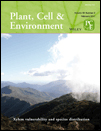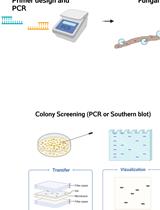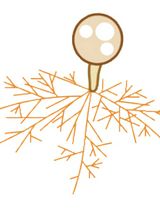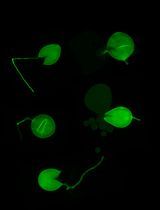- EN - English
- CN - 中文
Establishing a Symbiotic Interface between Cultured Ectomycorrhizal Fungi and Plants to Follow Fungal Phosphate Metabolism
在培养的外生菌根真菌和植物之间建立共生界面以示踪真菌磷酸盐代谢
发布: 2017年10月20日第7卷第20期 DOI: 10.21769/BioProtoc.2577 浏览次数: 7915
评审: Scott A M McAdamZhaohui LiuAnonymous reviewer(s)
Abstract
In ectomycorrhizal plants, the fungal cells colonize the roots of their host plant to create new organs called ectomycorrhizae. In these new organs, the fungal cells colonize the walls of the cortical cells, bathing in the same apoplasm as the plant cells in a space named the ‘Hartig net’, where exchanges between the two partners take place. Finally, the efficiency of ectomycorrhizal fungi to improve the phosphorus nutrition of their host plants will depend on the regulation of phosphate transfer from the fungal cells to plant cells in the Hartig net through as yet unknown mechanisms. In order to investigate these mechanisms, we developed an in vitro experimental device mimicking the common apoplasm of the ectomycorrhizae (the Hartig net) to study the phosphorus metabolism in the ectomycorrhizal fungus Hebeloma cylindrosporum when the fungal cells are associated or not with the plant cells of the host plant Pinus pinaster. This device can be used to monitor 32Phosphate efflux from the fungus previously incubated with 32P-orthophosphate.
Keywords: In vitro symbiotic interface (体外共生界面)Background
The association between mycorrhizal fungi and plants is known to improve plant P nutrition (reviewed by Smith and Read, 2008; Plassard and Dell, 2010; Cairney, 2011; Smith et al., 2015). This positive effect is due to P uptake and P transport through the fungal cells exploring soil far away from the roots. The capacity of the fungus to take up P from the soil solution and to release P to mycorrhizal roots is therefore an important feature for its positive effect on plant P nutrition. In ectomycorrhizal symbiosis, we know (i) that the exchanges between the fungus and the plant occur in the Hartig net, located inside the ectomycorrhizae, and (ii) that there is no direct cellular connection via, for example plasmodesmata, between the plasma membrane of the fungal and the plant cells. Therefore, these exchanges are very difficult to study as they occur in the apoplasmic space of the Hartic net. Here, we describe an in vitro system enabling us to mimick this apoplasmic space for the ectomycorrhizal fungus Hebeloma cylindrosporum incubated with its host plant Pinus pinaster (Torres-Aquino et al., 2017). This method could be used with other fungal or plant species.
Materials and Reagents
- Sterile plastic 90 mm Petri dishes (Dominique DUTSCHER, Gosselin, catalog number: 688302 )
- Gloves, EcoSHIELD Natural Nitrile PF 250 (Dominique DUTSCHER)
- Multi-Purpose Silicone for kitchen or bathroom, 280 ml (Castorama, Rubson)
- PTFE (Polytetrafluoroethylene) microtube, 1.15 mm and 1.75 mm for internal and external diameter, respectively (Dominique DUTSCHER, PTFE, catalog number: 091932 )
- Filter paper without ash, grade 542, 185 mm diameter (Dominique DUTSCHER, WhatmanTM, catalog number: 1542185 )
- Autoclavable bags Polypropylene bag, 3 L, non-printed (Dominique DUTSCHER, catalog number: 140230 )
- Autoclave tape (Dominique DUTSCHER, catalog number: 490009 )
- Sterile 60 ml syringes 3 pieces (Dominique DUTSCHER, Omnifix, catalog number: 921010 )
- Sealing film for manual application, roll of 38 m x 100 mm (VWR, PARAFILM® M, catalog number: 291-1213 )
- Needles 18 G 0.9 x 40 mm (Dominique DUTSCHER, MicrolanceTM 3, catalog number: 301300 )
- Tubing, int diam 1.14 mm (Dominique DUTSCHER, Silicone, catalog number: 4906591 )
- Tubing, int diam 3.17 mm (Dominique DUTSCHER, Silicone, catalog number: 4906600 )
- 125 ml sterile polypropylene containers, red cap (Dominique DUTSCHER, catalog number: 688270 )
- Tips 200 µl for pipet (Dominique DUTSCHER, Sartorius, catalog number: 070468 )
- Tips 10 µl for pipet (Dominique DUTSCHER, Sartorius, catalog number: 077179 )
- Home-made needle holder for aeration
- Sterile syringe filters for air, 0.2 µm, 6.4 cm diam (Labomoderne, Midisart, catalog number: RS3320 )
- Nichrome wire, stainless steel, round, 22 gauge, 0.64 mm diameter (suppliers for electronic cigarettes)
- Valve luer polycarbonate one way (Cole-Parmer, catalog number: EW-30600-01 )
- Folding skirted caps, 14.9 mm diam (Dominique DUTSCHER, catalog number: 110603 )
- Paper for sterilisation (Dominique DUTSCHER, catalog number: 006950 )
- Pinus pinaster (maritime pine), seeds (Vilmorin, catalog number: PPA301 massif landais)
- Hebeloma cylindrosporum (ectomycorrhizal basidiomycete) (laboratory’s own collection, available upon request)
- Agar-agar (Sigma-Aldrich, catalog number: A7002-500G )
- D-glucose (Sigma-Aldrich, catalog number: G8270-1KG )
- Concentrated (30%) hydrogen peroxide (H2O2) solution (Sigma-Aldrich, catalog number: 216763-500ML-M )
- Manganese(II) sulfate monohydrate (MnSO4·H2O) (Sigma-Aldrich, catalog number: M7899-500G )
- Zinc sulfate heptahydrate (ZnSO4·7H2O) (Sigma-Aldrich, catalog number: Z0251-100G )
- Boric acid (H3BO3) (Sigma-Aldrich, catalog number: B6768-500G )
- Copper(II) sulfate pentahydrate (CuSO4·5H2O) (Sigma-Aldrich, catalog number: C8027-500G )
- Calcium nitrate tetrahydrate (Ca(NO3)2·4H2O) (Sigma-Aldrich, catalog number: C2786-500G )
- Potassium nitrate (KNO3) (Sigma-Aldrich, catalog number: P8291-500G )
- Potassium dihydrogen phosphate (KH2PO4) (EMD Millipore, catalog number: 105108 )
- Magnesium sulfate heptahydrate (MgSO4·7H2O) (Sigma-Aldrich, catalog number: 63138-250G )
- Potassium chloride (KCl) (Sigma-Aldrich, catalog number: P9333-500G )
- Calcium chloride dihydrate (CaCl2·2H2O) (Sigma-Aldrich, catalog number: C5080-500G )
- Calcium hydroxide (Ca(OH)2) (EMD Millipore, catalog number: 102047 )
- Ammonium iron(III) citrate (NH4FeC6H5O7) (Sigma-Aldrich, catalog number: RES20400-A702X )
- Calcium sulfate dihydrate (CaSO4·2H2O) (EMD Millipore, catalog number: 102161 )
- 2-N-morpholino-ethanesulfonic acid, 4-morpholineethanesulfonic acid monohydrate (MES) (Sigma-Aldrich, catalog number: 69892-500G )
- Tris(hydroxymethyl)aminomethane (TRIS) (Sigma-Aldrich, catalog number: T1378-500G )
- 1 N sulfuric acid solution (EMD Millipore, catalog number: 1.09072.1000 )
- Agar plates for germination (see Recipes)
- 0.1 N Ca(OH)2 solution(see Recipes)
- Trace elements (1,000 ml) (see Recipes)
- Mineral salt base solutions (100 ml) (see Recipes)
- N1 + P solution (1,000 ml) (see Recipes)
- CaSO4 solution (0.2 mM) (see Recipes)
- Interaction medium (1,000 ml) (see Recipes)
Equipment
- A pair of stainless steel straight tweezers Wironit, Brucelles type, 130 mm (Dominique DUTSCHER, catalog number: 491037 )
- Glass bottles, 250 ml, ISO borosilicate, graduated (Dominique DUTSCHER, catalog number: 046413B )
- Glass bottles, 1000 ml, ISO borosilicate, graduated (Dominique DUTSCHER, catalog number: 046415 )
- Glass bottles, 2,000 ml, ISO borosilicate, graduated (Dominique DUTSCHER, catalog number: 046416 )
- Borosilicate glass funnel, 60° angle, 8 ml (Dominique DUTSCHER, catalog number: 068957 )
- A standalone burner (Dominique DUTSCHER, catalog number: 071109 )
- Butane gas cartridge for the burner (Dominique DUTSCHER, catalog number: 060415 )
- Automatic Piezo electronic gas lighter (Dominique DUTSCHER, catalog number: 076275 )
- Air-pumps for aquarium (SuperFish, model: air-box Nr.4 )
- Graduated borosilicate glass beaker 400 ml (Dominique DUTSCHER, catalog number: 068939 )
- Graduated borosilicate glass beaker 1,000 ml (Dominique DUTSCHER, catalog number: 068942 )
- Polypropylene economical beaker 3,000 ml with moulded graduations (Dominique DUTSCHER, catalog number: 391134 )
- Soda-lime glass Petri dish 150 x 25 mm (Dominique DUTSCHER, catalog number: 068522 )
- Glass tubing, length 150 mm, ext diameter 8 mm (VWR, AR-Glas®, catalog number: SCOR1193467 )
- Test tube, borosilicate glass, height 150 mm, internal diameter 20 mm (VWR, Duran, catalog number: 212-1120 )
- Stainless steel racks for 6 x 4 tubes of 16-20 mm diameter (Dominique DUTSCHER, catalog number: 854061 )
- A nail and cutting pliers
- A glass cutting knife (Sigma-Aldrich, catalog number: Z136441 )
- One stainless steel spatula, 235 mm (Dominique DUTSCHER, catalog number: 001809 )
- Autoclave
- Laminar flow cabinet, horizontal (Dominique DUTSCHER, catalog number: 486084 )
- Growth cabinet with controlled light, temperature and humidity (Binder, model: KBF P 720 )
Software
- Microsoft Excel for calculations
- Statistica 7.1 (StatSoft Inc., Tulsa, OK, USA)
Procedure
文章信息
版权信息
© 2017 The Authors; exclusive licensee Bio-protocol LLC.
如何引用
Becquer, A., Torres-Aquino, M., Le Guernevé, C., Amenc, L. K., Trives-Segura, C., Staunton, S., Quiquampoix, H. and Plassard, C. (2017). Establishing a Symbiotic Interface between Cultured Ectomycorrhizal Fungi and Plants to Follow Fungal Phosphate Metabolism. Bio-protocol 7(20): e2577. DOI: 10.21769/BioProtoc.2577.
分类
植物科学 > 植物生理学 > 营养
细胞生物学 > 组织分析 > 生理学
微生物学 > 微生物-宿主相互作用 > 真菌
您对这篇实验方法有问题吗?
在此处发布您的问题,我们将邀请本文作者来回答。同时,我们会将您的问题发布到Bio-protocol Exchange,以便寻求社区成员的帮助。
提问指南
+ 问题描述
写下详细的问题描述,包括所有有助于他人回答您问题的信息(例如实验过程、条件和相关图像等)。
Share
Bluesky
X
Copy link













